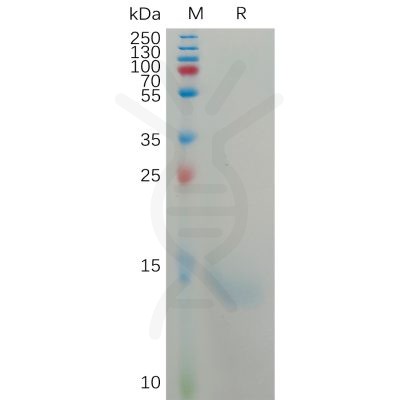| TARGET | |
|---|---|
| SYNONYMS |
GCP-1;GCP1;IL8;LECT;LUCT;LYNAP;MDNCF;MONAP;NAF;NAP-1;NAP1;SCYB8 |
| DESCRIPTION |
Recombinant Human CXCL8 Protein with C-terminal 6×His tag |
| DELIVERY |
In Stock |
| UNIPROT ID |
P10145 |
| EXPRESSION HOST |
HEK293 |
| TAG |
C-6×His Tag |
| MOLECULAR CHARACTERIZATION |
CXCL8(Ser28-Ser99) 6×His tag |
| MOLECULAR WEIGHT |
The protein has a predicted molecular mass of 9.2 kDa after removal of the signal peptide. The apparent molecular mass of CXCL8-His is approximately 10-15 kDa due to glycosylation. |
| PURITY |
The purity of the protein is greater than 85% as determined by SDS-PAGE and Coomassie blue staining. |
| FORMULATION & RECONSTITUTION |
Lyophilized from sterile PBS, pH 7.4. Normally 5 % – 8% trehalose is added as protectants before lyophilization. Please see Certificate of Analysis for specific instructions of reconstitution. |
| STORAGE & SHIPPING |
Store at -20°C to -80°C for 12 months in lyophilized form. After reconstitution, if not intended for use within a month, aliquot and store at -80°C (Avoid repeated freezing and thawing). Lyophilized proteins are shipped at ambient temperature. |
| BACKGROUND |
The protein encoded by this gene is a member of the CXC chemokine family and is a major mediator of the inflammatory response. The encoded protein is commonly referred to as interleukin-8 (IL-8). IL-8 is secreted by mononuclear macrophages, neutrophils, eosinophils, T lymphocytes, epithelial cells, and fibroblasts. It functions as a chemotactic factor by guiding the neutrophils to the site of infection. Bacterial and viral products rapidly induce IL-8 expression. IL-8 also participates with other cytokines in the proinflammatory signaling cascade and plays a role in systemic inflammatory response syndrome (SIRS). This gene is believed to play a role in the pathogenesis of the lower respiratory tract infection bronchiolitis, a common respiratory tract disease caused by the respiratory syncytial virus (RSV). The overproduction of this proinflammatory protein is thought to cause the lung inflammation associated with csytic fibrosis. This proinflammatory protein is also suspected of playing a role in coronary artery disease and endothelial dysfunction. This protein is also secreted by tumor cells and promotes tumor migration, invasion, angiogenesis and metastasis. This chemokine is also a potent angiogenic factor. The binding of IL-8 to one of its receptors (IL-8RB/CXCR2) increases the permeability of blood vessels and increasing levels of IL-8 are positively correlated with increased severity of multiple disease outcomes (eg, sepsis). This gene and other members of the CXC chemokine gene family form a gene cluster in a region of chromosome 4q. [provided by RefSeq, May 2020] |
| USAGE |
Research use only |
1
/
의
1
Dima Biotech
SKU(재고 관리 코드):PME101168
Human CXCL8 Protein, His Tag
Human CXCL8 Protein, His Tag
PRODUCT DATA
IMAGES

Figure 1. Human CXCL8 Protein, His Tag on SDS-PAGE under reducing condition.
Share


